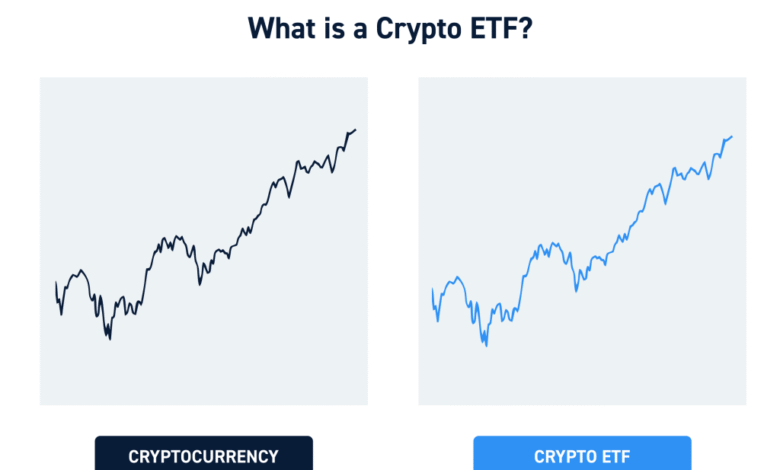Crypto ETFs Experience Nearly $1 Billion in Redemptions

Crypto ETFs, or exchange-traded funds that focus on digital currencies, have recently faced an extraordinary challenge, experiencing nearly $1 billion in redemptions on August 19. This significant outflow can be largely attributed to cautious investor sentiment, particularly surrounding bitcoin ETFs, which alone saw losses exceeding $523 million. In contrast, ether ETFs were not spared either, with a staggering $430 million in outflows marking a challenging day for the sector. Fidelity crypto funds were at the center of this turmoil, exemplifying the market’s vulnerability as no ETF recorded any inflow. As trading activities remain high, these developments highlight the ongoing uncertainty in crypto investments, urging investors to reevaluate their strategies amidst fluctuating conditions.
Cryptocurrency-focused exchange-traded funds are increasingly capturing attention within the financial world as investors seek exposure to digital assets. Often referred to as digital asset ETFs, these funds offer a convenient way for individuals to engage with cryptocurrencies like Bitcoin and Ethereum without acquiring the assets directly. Recent reports indicate a significant trend of cash withdrawals from these funds, commonly known as ETF redemptions, emphasizing a shift in investor behavior. Large institutions such as Fidelity have entered the fray, launching their own crypto investment products aimed at capitalizing on the growing market. As investor confidence ebbs and flows, the fate of digital asset ETFs remains a focal point for those navigating the complexities of cryptocurrency markets.
Current State of Crypto ETFs: A Disheartening Trend
The current landscape for crypto exchange-traded funds (ETFs) has been marked by alarming declines, with nearly $1 billion in redemptions recorded in a single day. This staggering figure is compounded by the reality that Bitcoin ETFs, such as Fidelity’s FBTC and Grayscale’s GBTC, accounted for the bulk of these losses—over half a billion dollars flowed out of crypto ETFs overnight. The growing trend of outflows underscores a significant downturn, indicative of investor hesitation and a shift in market sentiment surrounding crypto investments.
Investors are reevaluating their strategies as the volatility of the market continues to exert pressure on crypto ETFs. In light of this, many are choosing to liquidate their holdings rather than ride the waves of uncertainty, amplifying the already significant redemptions observed across various crypto assets. The scale of outflows not only affects the stability of Bitcoin and Ether ETFs but also adds an element of caution among potential investors, who may now regard these funds as riskier than before.
Impact of Redemptions: Bitcoin vs Ether ETFs
The impact of redemptions is particularly pronounced in the Bitcoin ETF segment, which saw over $523 million exit the market on a single day. This included striking losses from top funds like Fidelity’s FBTC, which reported the largest individual loss of $246.89 million. Such substantial withdrawals indicate a waning confidence among investors, as they preemptively address potential downturns instead of sustaining their positions amidst fluctuating valuations.
In the Ether ETF sphere, the losses were similarly staggering, totaling nearly $430 million. Fidelity’s FETH, along with Grayscale’s ETHE, accounted for a combined loss that pushes the need for a cautious approach among investors who fear deeper market corrections. This dual threat across both Bitcoin and Ether ETFs emphasizes a broader trend in crypto investments where fear and caution may be overshadowing previously bullish sentiments toward digital assets.
Fidelity Crypto Funds: Leading the Exodus
Fidelity’s crypto funds have seen remarkable losses, leading the pack in ETF redemptions. The substantial outflows from funds like FBTC and FETH highlight the asset management giant’s significant exposure within the volatile crypto space. These redemptions pose questions regarding Fidelity’s strategies in managing these risks and whether it will pivot or double down on its crypto offerings in the future.
Despite the challenges faced by Fidelity’s crypto funds, this situation can also be viewed as an opportunity for restructuring and reassessing their investment strategies. As many investors pull capital out amid declining prices, Fidelity may need to enhance its communication and investor education efforts to retain client confidence in its crypto ETFs, making adjustments that align better with the current market environment.
Market Dynamics: High Trading Volume Amidst Exits
While the crypto ETF market sees unprecedented outflows, it’s noteworthy that trading volumes remain robust, with $4.75 billion in Bitcoin ETF trades and $2.76 billion in Ether ETF transactions occurring amidst the exodus. This paradox of high trading volume yet low net asset growth emphasizes the complex dynamics at play within the market. Investors are clearly engaged, but their willingness to redeem far outweighs the influx of new capital, signaling an urgent need for the industry to regain trust.
The dichotomy of high trading activity coupled with significant capital flight may highlight a transitional period for the crypto market, affected by macroeconomic factors and overall market sentiment. As investors adjust their portfolios, the ability of crypto ETFs to respond and adapt to evolving trends will be critical for future stability and attractiveness, particularly in light of changing attitudes toward crypto investments.
Future Outlook: Are Crypto ETFs in a Long-Term Decline?
Given the recent trends of outflows, the future outlook for crypto ETFs remains uncertain. Analysts speculate whether these withdrawals represent a temporary phase prompted by rapid market fluctuations or if they indicate the beginnings of a prolonged decline across these investment vehicles. The reaction of institutional investors will be particularly telling, as their participation could crucially alter the trajectory of ETF performance over the coming months.
Moreover, how the broader market reacts to regulatory developments, economic news, and fundamental changes in the crypto landscape will undoubtedly influence this segment. Investors will need to stay vigilant, watching both market movements and the performance of prominent funds like Fidelity’s crypto ETFs to understand whether the current environment is a fleeting weakness or more indicative of an ongoing correction within the crypto asset ecosystem.
Understanding ETF Redemptions: What Investors Should Know
ETF redemptions are an essential aspect that every investor should comprehend, especially in the context of high volatility in the crypto market. When investors choose to redeem their shares in ETFs, it signifies a drive to liquidate their positions, often due to unfavorable market conditions or the desire to safeguard gains. In the current climate, an influx of redemptions can severely impact fund performance and market relevance.
Understanding how ETF redemptions work is crucial for both current and potential investors. For example, when a fund like Fidelity’s FBTC experiences significant outflows, it may lead to increased pressure on the remaining assets and could dilute the fund’s value. Investors should consider this interplay of investor sentiment, fund management strategies, and market conditions when navigating their own crypto investments.
Comparing ETF Performance: Bitcoin vs. Ether
A closer examination of the performance of Bitcoin and Ether ETFs recently illustrates notable disparities that could influence future investment decisions. Bitcoin ETFs, particularly those from Fidelity and Grayscale, have endured larger outflows compared to Ether ETFs, indicating a more significant divergence in investor confidence between the two. These trends may guide potential investors in selecting which types of crypto assets to pursue based on performance history and relative stability.
Moreover, the contrasting dynamics between Bitcoin and Ether ETFs highlight critical areas for potential recovery strategies. For example, Ether ETFs like Grayscale’s ETHE are still experiencing robust trading volumes despite redemptions, which may signal an underlying confidence that can be nurtured moving forward. As investors analyze these patterns, the differentiation between Bitcoin and Ether can help inform their allocation strategies in the increasingly competitive landscape of crypto ETFs.
The Role of Institutional Investors in Crypto ETFs
Institutional investors play a critical role in the performance and acceptance of crypto ETFs. Their decision-making processes and investment habits can significantly influence market trends, especially when large traditional funds or institutions pour capital into or withdraw from these investment vehicles. Currently, the persistent redemptions in both Bitcoin and Ether ETFs may reflect a cautious approach from these institutional players, who may be evaluating the long-term viability of the space amidst heightened uncertainty.
As the crypto market continues to evolve, the participation of institutional investors will serve as a barometer for confidence in crypto ETFs. Their actions are reflective of broader trends in hesitancy and caution. Should institutional interest wane further, the impact on overall capital availability and market liquidity could be profound, prolonging the current trend of ETF redemptions and affecting future growth in the sector.
Strategies for Investors: Navigating the Crypto ETF Market
Navigating the crypto ETF market requires a strategic approach, especially during times of heightened volatility and redemption activity. Investors should adopt a comprehensive strategy that involves closely monitoring market conditions, evaluating fund performance, and diversifying their portfolios to minimize risks associated with potential outflows. Having a diversified approach can help mitigate adverse impacts while still providing opportunities for returns in the long run.
Additionally, engaging with educational resources and staying abreast of market news will empower investors to make informed decisions. Understanding the nuances of crypto ETFs—including specific risks, potential rewards, and their correlation to broader market events—will be essential for navigating this landscape. As redemption trends highlight underlying tensions in the market, having a proactive investment strategy can help position investors for future success.
Frequently Asked Questions
What are Crypto ETFs and how do they work?
Crypto ETFs, or Exchange-Traded Funds that focus on cryptocurrencies, allow investors to gain exposure to crypto investments like bitcoin and ether without needing to buy the cryptocurrencies directly. These funds are traded on stock exchanges and provide a way to invest in cryptocurrency markets while benefiting from the liquidity and regulatory framework of traditional financial markets.
Why are Bitcoin ETFs experiencing significant redemptions?
Bitcoin ETFs are facing significant redemptions, with nearly $523 million exiting the market recently due to cautious investor sentiment. Market volatility and profit-taking after recent gains have led many investors to divest from bitcoin ETFs, resulting in no funds recording inflows during this period.
What is causing the outflow from Ether ETFs?
Ether ETFs have also seen substantial outflows, totaling approximately $430 million, primarily driven by investor caution and a desire to secure profits after a recent market surge. Lack of inflows and consistent redemptions suggest a bearish sentiment in the ether market among investors.
How do ETF redemptions impact the overall crypto market?
ETF redemptions, particularly from Bitcoin and Ether ETFs, can impact the overall crypto market by signaling decreasing investor confidence and potential market corrections. Large outflows can pressure associated cryptocurrencies and affect trading volumes, as seen with the recent drop in net assets for these ETFs.
What should investors consider before investing in Crypto ETFs?
Investors should consider market volatility, historical performance, and current trends in the crypto market before investing in Crypto ETFs. Understanding the specific holdings within the ETFs, such as the performance of underlying assets like Bitcoin and Ether, as well as the regulatory landscape, is also crucial.
What role do Fidelity crypto funds play in the current ETF landscape?
Fidelity crypto funds are significant players in the ETF landscape, leading recent redemptions with substantial outflows from their Bitcoin and Ether ETF offerings. Their performance often reflects broader market trends and investor sentiment, making them a focal point for those monitoring the crypto ETF sector.
Are Crypto ETFs a safe investment compared to direct crypto investments?
Crypto ETFs are generally considered safer than direct crypto investments due to their regulatory oversight and diversification across multiple assets. However, they still carry inherent risks associated with the volatility of cryptocurrencies and market fluctuations.
How do trading volumes relate to Crypto ETFs and their performance?
Trading volumes for Crypto ETFs provide insight into market activity and liquidity. High trading volumes, like the recent $4.75 billion in Bitcoin ETFs, indicate strong interest even amid redemptions, suggesting that while outflows are significant, investor engagement remains robust.
What future trends can we expect for Bitcoin and Ether ETFs?
Future trends for Bitcoin and Ether ETFs will likely depend on market conditions, investor sentiment, and macroeconomic factors. Continued scrutiny on regulations, potential approval for new funds, and market recovery post-redemptions will be critical elements to watch for the performance of these ETFs.
| ETF Type | Total Redemptions ($ Million) | Notable Funds & Outflows ($ Million) |
|---|---|---|
| Bitcoin ETFs | 523.31 | Fidelity FBTC: -246.89 Grayscale GBTC: -115.53 Bitwise BITB: -86.76 Ark 21shares ARKB: -63.35 Others: -7.51, -3.27 |
| Ether ETFs | 429.73 | Fidelity FETH: -156.32 Grayscale ETHE: -122.05 Others: -88.53, -39.80, -7.44, -6.29, -3.03, -6.27 |
Summary
Crypto ETFs have faced a challenging period, highlighted by nearly $1 billion in redemptions this week as investors pull funds amidst market uncertainty. The significant outflows particularly in bitcoin and ether funds indicate a cautious approach among investors following a recent surge. The lack of inflows and high trading volumes suggest that while activity remains, the overall sentiment may be tilting towards a more conservative stance. Monitoring these trends will be essential to determine the future of Crypto ETFs in the evolving market landscape.




